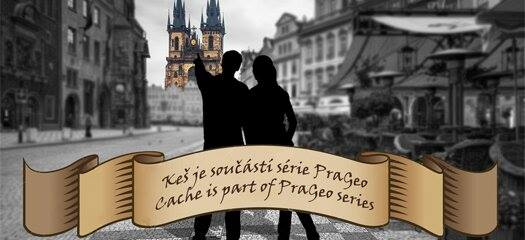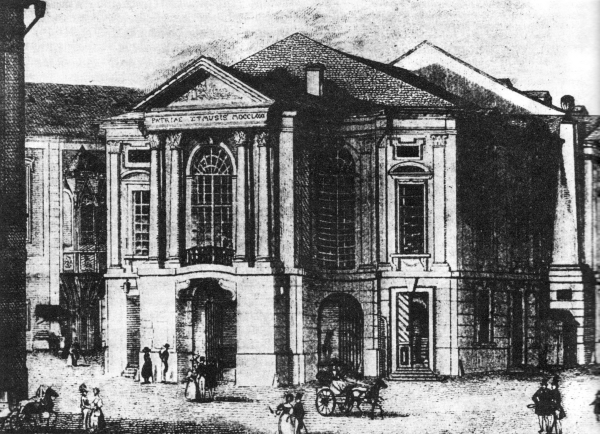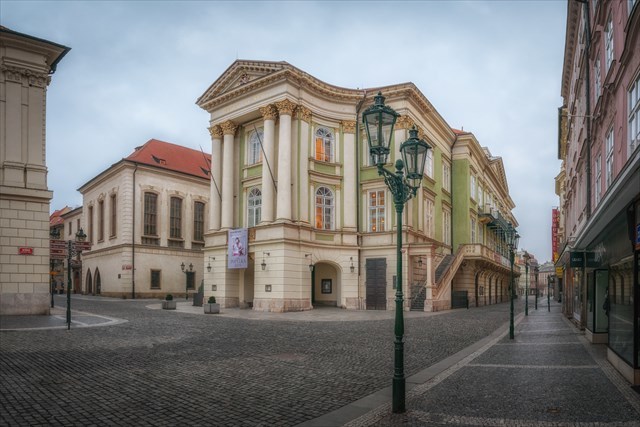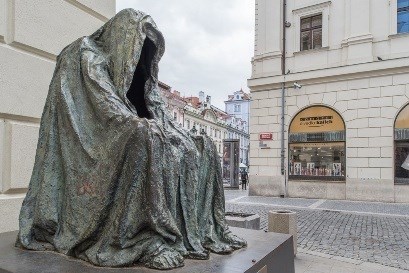|

 Vítejte u mé další keše, tentokrát v samotném srdci Prahy. Jedná se o jednoduchou tradičku na hodně frekventovaném místě. Má za úkol ukázat vám zajímavé pražské divadlo. Vítejte u mé další keše, tentokrát v samotném srdci Prahy. Jedná se o jednoduchou tradičku na hodně frekventovaném místě. Má za úkol ukázat vám zajímavé pražské divadlo.
 Welcome to my next cache, this time in the very heart of Prague, it is a classic traditional geocache in a very popular tourist area. Its task is to show you an interesting Prague theatre. Welcome to my next cache, this time in the very heart of Prague, it is a classic traditional geocache in a very popular tourist area. Its task is to show you an interesting Prague theatre.

 Stavovské divadlo Stavovské divadlo
Stavovské divadlo (puvodní název Hrabecí Nosticovo divadlo, za komunismu Tylovo divadlo) je divadlo v Praze na Ovocném trhu. Budovu dal postavit jako scénu pro verejnost osvícený patriot hrabe František Antonín Nostic-Rieneck. Plány divadla nakreslil hrabe Künigel a stavbu provedl dvorní stavitel Antonín Haffenecker. Stavba trvala dva roky, klasicistní budovu otevrela 21. dubna roku 1783 Lessingova tragédie Emilia Galotti. Divadlo tehdy pojalo jeden tisíc návštevníku. Casem byla kapacita, pro vetší pohodlí diváku, snížena na dnešních 659 míst.
Puvodne mel hrabe Nostic-Rieneck predstavu uvádet v divadle nemeckou cinohru a italskou operu. Brzy však byl repertoár rozšíren i o ceskou produkci a to v lednu roku 1785 veselohrou Gottlieba Stephanieho Odbehlec z lásky synovské.
V divadle po svém príjezdu do Prahy v roce 1787 vystoupil sám Mozart a na koncerte 20. ledna osobne dirigoval svoji Figarovu svatbu, která ve Vídni nedosáhla úspechu. Nadšení Pražanu bylo veliké. Mistr dojat srdecným prijetím, se rozhodl složit pro Prahu operu Don Giovanni. Premiéru této opery v roce 1787 opet sám dirigoval. Zejména tato opera divadlo proslavila a Mozartovými operami se stalo Stavovské divadlo známým po celém kulturním svete. Další premiéra Mozartovy opery La clemenza di Tito se odehrála pri korunovaci císare Leopolda II. ceským králem roku 1791.
Pozdeji divadlo odkoupili od hrabete ceští stavové a prejmenovali Nosticovo divadlo na Stavovské. František Škroup se v roce 1827 stal druhým kapelníkem Stavovského divadla. Stavovské divadlo ve smyslu ceském nabývá pak významu až po první svetové válce, kdy bylo pricleneno k divadlu Národnímu.
Po revoluci v roce 1945 byla zahájena predstavení ve Stavovském divadle Jiráskovou hrou Lucerna. Soucasne s novým divadelním statutem dostalo dne v ríjnu 1949 Stavovské divadlo i nové jméno – Tylovo divadlo.
Dnes je Stavovské divadlo druhou scénou Národního divadla. Vedle cinoherního souboru zde pusobí také opera Národního divadla, která zde provozuje až na výjimky predevším mozartovský repertoár. Srdci ceského cloveka je blízké a drahé nejen jako dejište desítky let trvajících boju o ceské divadlo, ale predevším jako místo, kde poprvé zaznela naše národní hymna.

 The Estates Theatre The Estates Theatre
The Estates Theatre was built during the late 18th century in response to Enlightenment thought regarding general access to the theatre, and theatres themselves demonstrating the cultural standards of a nation. The Estates Theatre was built in a little less than two years by the aristocrat František Antonín Count Nostitz Rieneck. In its first few years of existence it was known as Count Nostitz’s Theatre. The theatre opened in 1783 with a performance of the tragedy Emilia Galotti by the German playwright Gotthold Lessing. The building itself was constructed in a Neoclassical style and remains one of the few European theatres to be preserved in its almost original state to the present day. Its motto, Patriae et Musis (To the Native Land and the Muses), which is inscribed above the portal, should also be noted as the original intentions of its creator.
The Estates Theatre underwent several changes in its history. It first acquired the name Royal Theatre of the Estates in 1798 when it was purchased by the Czech Estates. With the opening of the Provisional Theatre in 1862, the Theatre of the Estates was dedicated to a German ensemble and renamed the Royal Provincial German Theatre. During the period between 1920 and 1948 the theatre regained the name Theatre of the Estates and became affiliated with the National Theatre. In 1948 the theatre was renamed the Tyl Theatre (after dramatist J.K. Tyl) and would be known as such until 1990 when, at the end of an eight year reconstruction project, it became known again as the Estates Theatre.
While the theatre was initially built with the intention of producing German dramas and Italian operas, works in other languages were also staged. Czech productions were first staged in 1785 in order to reach a broader Czech audience but by 1812 they became a regular feature of Sunday and holiday matinees. The somewhat political nature of these performances later led to idea of founding a National Theatre after 1848 with the defeat of the revolution and the departure of J.K. Tyl. Many of the founding Czech dramatists were involved in the Estates Theatre, such as the brothers Thám (Karel and Václav), J.K. Tyl, Ján Kollár, and so on. The first Czech modern opera, František Škroup’s The Tinker, was staged here in 1826 and in 1834 the song “Where is my Home?” (Kde domov muj) was first sung (words by Tyl, music by Škroup), which would later become the Czech national anthem.
The Estates Theatre was not limited to native participants; many famous European artists were also active. Individuals such as Carl Maria von Weber, Anton Rubinstein, Karl Goldmark, and Gustav Mahler conducted at the Estates Theatre. Other famous names include the actors A.W. Iffland, F. Raimund, J.N. Nestroy, along with opera singer Angelica Catalani and violin virtuoso Niccolò Paganini. One of the Estates Theatre’s many claims to glory is its strong link with Wolfgang Amadeus Mozart, who directed the world premiere of his opera Don Giovanni here in October 1787. Also, in 1791, Mozart’s La Clemenza di Tito was staged in public here for the first time in celebration of the coronation of Emperor Leopold II. It is the only theatre left standing where Mozart performed. 
Plášť svědomí / Cloak of Conscience  Nejznámější dílo české malířky a sochařky Anny Chromy, které se pod názvem "Plášť svědomí", "Commendatore" nebo "Pieta" nachází i v Salcburské katedrále, Národním archeologickém muzeu v Athénách a na dalších místech. Nejznámější dílo české malířky a sochařky Anny Chromy, které se pod názvem "Plášť svědomí", "Commendatore" nebo "Pieta" nachází i v Salcburské katedrále, Národním archeologickém muzeu v Athénách a na dalších místech.
 The most famous work of the Czech painter and sculptor Anna Chroma, which under the name "Cloak of Conscience", "Commendatore" or "Pieta" can also be found in the Salzburg Cathedral, the National Archaeological Museum in Athens and other places. The most famous work of the Czech painter and sculptor Anna Chroma, which under the name "Cloak of Conscience", "Commendatore" or "Pieta" can also be found in the Salzburg Cathedral, the National Archaeological Museum in Athens and other places.
 |